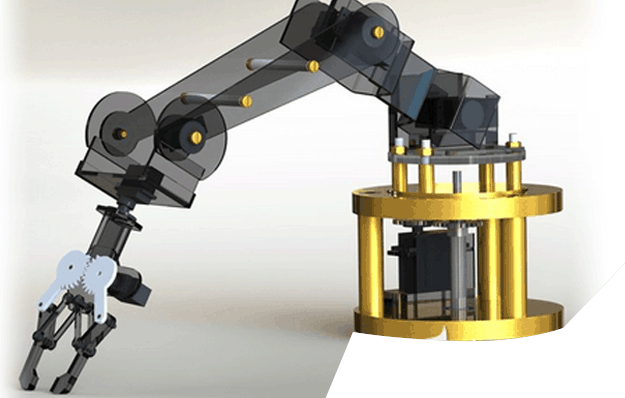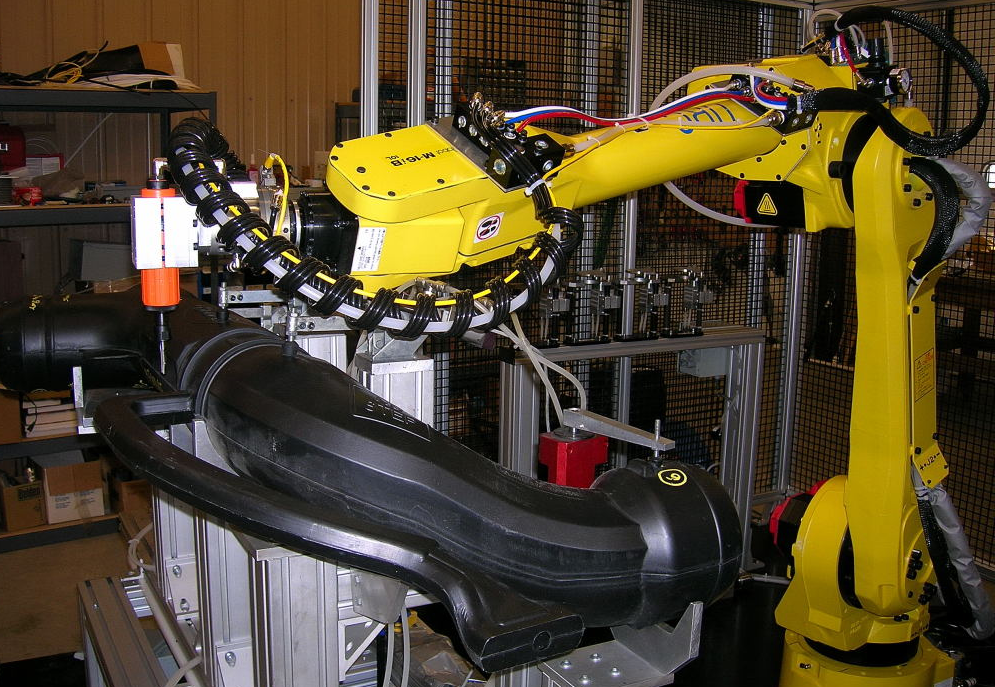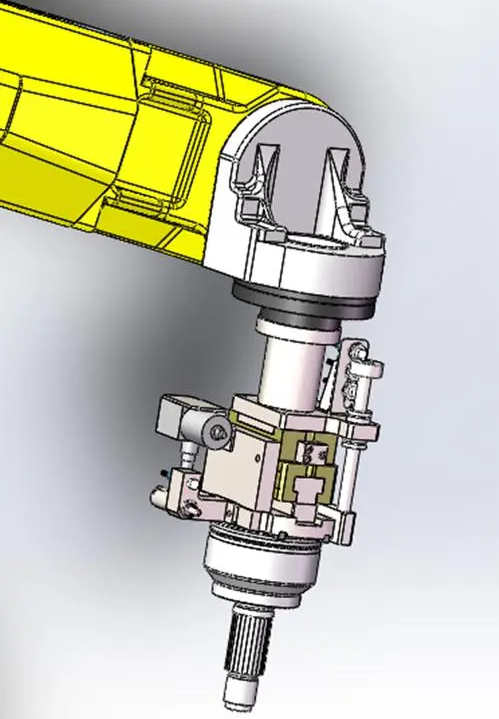By Panasonic 152
Industrial robots are defined according to ISO 8373 [1]. It is a multi-joint manipulator or multi-degree-of-freedom robot for the industrial field. An industrial robot is a machine device that performs work automatically, and is a machine that realizes various functions by its own power and control capabilities. It can be commanded by humans or run according to pre-programmed programs. Modern industrial robots can also act according to the principles and programs formulated by artificial intelligence technology.

There are many types of industrial robots, among which handling robots, palletizing robots, welding robots, and loading and unloading robots are our common types. These industrial robots will be equipped with sensors to realize on-site production and manufacturing.
Generally speaking, an industrial robot consists of three major parts and six subsystems. The three major parts are the mechanical part, the sensing part and the control part. The six subsystems can be divided into mechanical structure system, drive system, perception system, robot-environment interaction system, human-computer interaction system and control system. Today we are going to introduce the sensing part.
A sensor is a physical device or biological organ that can detect and sense external signals, physical conditions (such as light, heat, humidity) or chemical composition (such as smoke), and transmit the detected information to other devices. "Sensor" is defined in New Webster's Dictionary as: "A device that receives power from one system and sends power, usually in another form, to a second system." According to this definition, the function of a sensor is to convert one kind of energy into another energy form, so many scholars also use "transducer-Transducer" to call "sensor-Sensor".

Types of industrial robot sensors:
1. Force distance sensor
The torque sensor is equivalent to the tactile sense of the intelligent welding robot. When the mechanical arm touches the workpiece, the torque sensor will feel the strength of the end effector, which can prevent the industrial robot from colliding and protect the mechanical arm from injury.
2. Photoelectric encoder sensor
A photoelectric encoder is a sensor capable of transmitting position information, consisting of a photoelectric encoding module and a code disc. The photoelectric encoder is mainly used as a feedback signal for control. The optocoupler measures the distance by measuring the rotation angle of the code disc that rotates with the wheel shaft to obtain the number of turns of the wheel.
3. Collision sensor
The main function of the collision sensor is to prevent the industrial robot from colliding with external objects during the working process, and to prevent the robot body from being damaged during the collision. There are 4 collision switches on the left front, right front, left rear, and right rear of the robot. Together they constitute a collision sensor, which will send out an alarm signal in time after being triggered and stop the operation in an emergency to reduce damage.
4. Vision sensor
Vision sensors are equivalent to the eyes of industrial robots. They can scan workpiece information from different angles and upload the information to the control system, which helps to improve work accuracy. Industrial robots have the function of automatic positioning, which is the role of visual sensors.
5. Infrared sensor
The infrared sensor of the robot includes two devices: an infrared emitting tube and an infrared receiving tube. The infrared receiving tube is located in front of the robot, and the two infrared emitting tubes are located on both sides of the infrared receiving tube. The infrared emitting tube can emit infrared rays. After being reflected back, objects that need work can be found in time.

The above are the types of industrial robot sensors. Various sensors cooperate with each other to complete the work, which improves the accuracy and speed of the work and realizes stable production.
Frequently Asked Questions
1. What are the categories of sensors according to their mode of action?
According to the form of action, it can be divided into active and passive sensors.
The active sensor has an active type and a reactive type. This kind of sensor can send a certain detection signal to the measured object, and can detect the change of the detection signal in the measured object, or the detection signal can generate a certain detection signal in the measured object. effect to form a signal. The way of detecting the change of the detection signal is called the action type, and the way of detecting the response to form a signal is called the reaction type. Radar and radio frequency range detectors are active examples, while photoacoustic effect analyzers and laser analyzers are reactive examples.
Passive sensors only receive signals generated by the measured object itself, such as infrared radiation thermometers, infrared camera devices, etc.
2. What are the categories of sensors by use?
Pressure-sensitive and force-sensitive sensors, position sensors, liquid level sensors, energy consumption sensors, speed sensors, acceleration sensors, radiation sensors, thermal sensors.
3. What are the categories of sensors according to their composition?
Basic sensor: It is the most basic single conversion device.
Combined sensor: a sensor composed of a combination of different single conversion devices.
Applied sensor: It is a sensor composed of a basic sensor or a combination sensor combined with other mechanisms.
4. What are the categories of sensors by principle?
Vibration sensor, humidity sensor, magnetic sensor, gas sensor, vacuum sensor, biological sensor, etc.
5. What are the categories of sensors according to the output signal?
Analog sensor: Convert the measured non-electrical quantity into an analog electrical signal.
Digital sensor: Convert the measured non-electrical quantity into a digital output signal (including direct and indirect conversion).
Pseudo-digital sensor: Convert the measured signal quantity into a frequency signal or a short-period signal output (including direct or indirect conversion).
Switch sensor: When a measured signal reaches a certain threshold, the sensor outputs a set low or high level signal accordingly.
6. What are the categories of sensors according to the measurement purpose?
Physical sensors are made by using the characteristics that certain physical properties of the measured substance change significantly.
Chemical sensors are made of sensitive elements that can convert chemical quantities such as the composition and concentration of chemical substances into electrical quantities.
Biosensors are made using the characteristics of various organisms or biological substances to detect and identify chemical components in organisms.
7. What are the categories of sensors by their manufacturing process?
The integrated sensors are fabricated using standard process technologies for producing silicon-based semiconductor integrated circuits. Usually also part of the circuit used to initially process the signal to be measured is also integrated on the same chip.
Thin film sensors are formed by depositing a thin film of the corresponding sensitive material on a dielectric substrate (substrate). When using a hybrid process, parts of the circuit can also be fabricated on this substrate.
The thick film sensor is made by coating the slurry of the corresponding material on the ceramic substrate, the substrate is usually made of Al2O3, and then undergoes heat treatment to shape the thick film.
Ceramic sensors are produced using the standard ceramic process or some variant of it (sol, gel, etc.).
After appropriate preparatory operations, the shaped components are sintered at high temperature. There are many commonalities between the two processes, thick film and ceramic sensors, and in some respects the thick film process can be considered a variant of the ceramic process.
Each process technology has its own advantages and disadvantages. Ceramic and thick film sensors are reasonable due to the low capital investment required for research, development and production, and the high stability of sensor parameters.